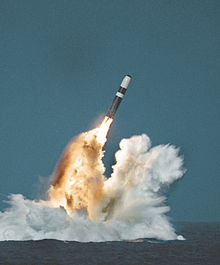UGM-133 Trident II
| UGM-133A Trident II | |
|---|---|

A Trident II launch from a submerged Royal Navy submarine.
|
|
| Type | SLBM |
| Place of origin | United States |
| Service history | |
| In service | March 1990 |
| Used by |
United States Navy Royal Navy |
| Production history | |
| Manufacturer | Lockheed Martin Space Systems |
| Unit cost | $37,320,070 (2014) |
| Produced | 1983 |
| Specifications | |
| Weight | 130,000 lb (59,000 kg) |
| Length | 44 ft 6.6 in (13.579 m) |
| Diameter | 6 ft 11 in (2.11 m) (1st stage) |
| Warhead | 8–12 thermonuclear MIRV (Multiple Independently Targetable re-entry Vehicle); Maneuverable Re-entry Vehicle, W88 or W76 thermonuclear weapons |
|
|
|
| Engine | Three Solid-fuel rocket motors; first & second stage – Thiokol/Hercules solid-fueled rocket; third stage – United Technologies Corp. solid-fueled rocket |
| Propellant | Nitrate ester, Plasticized Polyethylene Glycol |
|
Operational
range |
more than 7,456 miles (12,000 km) (exact is classified) |
| Speed | Approximately 18,030 mph (29,020 km/h) (Mach 24; 8,060 m/s)(terminal phase) |
|
Guidance
system |
MK 6 astro-inertial guidance which is able to receive GPS (Global Positioning System) updates |
|
Steering
system |
Single movable nozzle actuated by a gas generator |
| Accuracy | 90 m |
|
Launch
platform |
Ballistic missile submarine |
The UGM-133A Trident II, or Trident D5 is a submarine-launched ballistic missile (SLBM), built by Lockheed Martin Space Systems in Sunnyvale, California, and deployed with the American and British navies. It was first deployed in March 1990, and remains in service. The Trident II Strategic Weapons System is an improved SLBM with greater accuracy, payload, and range than the earlier Trident C-4. It is a key element of the U.S. strategic nuclear triad and strengthens U.S. strategic deterrence. The Trident II is considered to be a durable sea-based system capable of engaging many targets. It enhances the U.S. position in strategic arms negotiation with performance and payload flexibility that can accommodate active treaty initiatives (See New START). The Trident II's increased payload allows nuclear deterrence to be accomplished with fewer submarines, and its high accuracy – approaching that of land-based missiles – enables it to be used as a first strike weapon.
Trident II missiles are carried by 14 US Ohio and 4 British Vanguard-class submarines, with 24 missiles on each Ohio class and 16 missiles on each Vanguard class. There have been 161 successful test flights of the D5 missile since design completion in 1989, the most recent being from the USS Maryland (SSBN-738) in August 2016. There have been fewer than 10 test flights that were failures, the most recent being from HMS Vengeance (S31) off the coast of Florida in June 2016. The D5 is the sixth in a series of missile generations deployed since the sea-based deterrent program began 60 years ago. The Trident D5LE (life-extension) version will remain in service until 2042. Lockheed Martin designs and manufactures the Trident II Missile as well as all prior generations of US Fleet Ballistic Missiles.
...
Wikipedia
